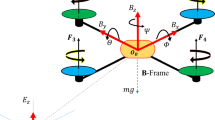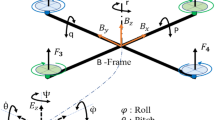Abstract
This paper deals with the robust flight control problem of quadrotor while taking various model uncertainties and external disturbances into consideration. The novel flight controller is proposed based on the chattering reduced terminal sliding mode control method and a universal nonlinear disturbance estimator (NDE), which is applied to improve the robustness of the flight system. By skillfully using Lyapunov theory, the stability condition of the closed-loop systems is derived and it is shown that the control gains can be reduced by estimating the model uncertainties and external disturbances. Finally, compared with traditional methods, the theoretical results are validated experimentally through tests using a quadrotor assembled with PX4 and Pixracer. Two different kinds of model uncertainties and external disturbances cases, including partial failure of a rotor and the sudden change of the load, are validated through experiments. Since the nonlinear disturbance estimator is designed in a universal way, the proposed method shows great robustness in the above two different experiment cases without changing the structure of the flight controller and the nonlinear disturbance estimator.
Similar content being viewed by others
Explore related subjects
Discover the latest articles and news from researchers in related subjects, suggested using machine learning.Code Availability
The complete experiment data is available by contacting the corresponding author.
References
Hou, Z., Wang, W., Zhang, G., Han, C.: A survey on the formation control of multiple quadrotors. In: 2017 14Th International Conference on Ubiquitous Robots and Ambient Intelligence (URAI), pp. 219–225. https://doi.org/10.1109/URAI.2017.7992717 (2017)
Yu, Z., Zhang, Y., Jiang, B., Yu, X.: Fault-tolerant time-varying elliptical formation control of multiple fixed-wing uavs for cooperative forest fire monitoring. J. Intell. Robot. Syst. 101(3), 1–15 (2021). https://doi.org/10.1007/s10846-021-01320-6
Huang, H., Savkin, A. V., Ni, W.: A method for covert video surveillance of a car or a pedestrian by an autonomous aerial drone via trajectory planning. In: 2020 6Th International Conference on Control, Automation and Robotics (ICCAR), pp. 446–449. https://doi.org/10.1109/ICCAR49639.2020.9108036 (2020)
Du, H., Zhu, W., Wen, G., Wu, D.: Finite-time formation control for a group of quadrotor aircraft. Aerosp. Sci. Technol. 69, 609–616 (2017). https://doi.org/10.1016/j.ast.2017.07.012
Zhang, Z., Wu, J., Dai, J., He, C.: A novel real-time penetration path planning algorithm for stealth uav in 3d complex dynamic environment. IEEE Access 8, 122757–122771 (2020). https://doi.org/10.1109/ACCESS.2020.3007496
Marshall, J. A., Anderson, R. B., Chien, W. -Y., Johnson, E. N., L’Afflitto, A.: A guidance system for tactical autonomous unmanned aerial vehicles. J. Intell. Robot. Syst. 103(4), 1–36 (2021). https://doi.org/10.1007/s10846-021-01526-8
Yu, Y., Ding, X.: A global tracking controller for underactuated aerial vehicles: design, analysis, and experimental tests on quadrotor. IEEE/ASME Trans. Mechatronics 21(5), 2499–2511 (2016). https://doi.org/10.1109/TMECH.2016.2558678
Bouabdallah, S., Noth, A., Siegwart, R.: Pid Vs Lq Control Techniques Applied to an Indoor Micro Quadrotor. In: 2004 IEEE/RSJ International Conference on Intelligent Robots and Systems (IROS) (1 Cat. No.04CH37566), Vol. 3, pp. 2451–24563. https://doi.org/10.1109/IROS.2004.1389776 (2004)
Castillo, P., Lozano, R., Dzul, A.: Stabilization of a mini rotorcraft with four rotors. IEEE Control. Syst. Mag. 25(6), 45–55 (2005). https://doi.org/10.1109/MCS.2005.1550152
Stojanovic, V., Nedic, N.: Robust identification of oe model with constrained output using optimal input design. J. Franklin Inst. 353(2), 576–593 (2016). https://doi.org/10.1016/j.jfranklin.2015.12.007
Bhargavapuri, M., Sahoo, S. R., Kothari, M.: Abhishek: Robust nonlinear control of a variable-pitch quadrotor with the flip maneuver. Control. Eng. Pract. 87, 26–42 (2019). https://doi.org/10.1016/j.conengprac.2019.03.012
Djordjevic, V., Stojanovic, V., Tao, H., Song, X., He, S., Gao, W.: Data-driven control of hydraulic servo actuator based on adaptive dynamic programming. Discrete Contin. Dyn. Syst. - S 11, 1–18 (2021). https://doi.org/10.3934/dcdss.2021145
Dou, L., Cai, S., Zhang, X., Su, X., Zhang, R.: Event-triggered-based adaptive dynamic programming for distributed formation control of multi-uav. J. Franklin Inst., 1–21. https://doi.org/10.1016/j.jfranklin.2022.02.034(2022)
Cheng, P., Wang, H., Stojanovic, V., He, S., Shi, K., Luan, X., Liu, F., Sun, C.: Asynchronous fault detection observer for 2-d markov jump systems. IEEE Trans. Cybern. 1–12. https://doi.org/10.1109/TCYB.2021.3112699 (2021)
Hou, Z., Lu, P., Tu, Z.: Nonsingular terminal sliding mode control for a quadrotor uav with a total rotor failure. Aerosp. Sci. Technol. 98, 105716 (2020). https://doi.org/10.1016/j.ast.2020.105716
Lotufo, M. A., Colangelo, L., Perez-Montenegro, C., Canuto, E., Novara, C.: Uav quadrotor attitude control: an adrc-emc combined approach. Control Eng. Pract. 84, 13–22 (2019). https://doi.org/10.1016/j.conengprac.2018.11.002
Castillo, A., Sanz, R., Garcia, P., Qiu, W., Wang, H., Xu, C.: Disturbance observer-based quadrotor attitude tracking control for aggressive maneuvers. Control. Eng. Pract. 82, 14–23 (2019). https://doi.org/10.1016/j.conengprac.2018.09.016
Yang, H., Cheng, L., Xia, Y., Yuan, Y.: Active disturbance rejection attitude control for a dual closed-loop quadrotor under gust wind. IEEE Trans. Control Syst. Technol. 26(4), 1400–1405 (2018). https://doi.org/10.1109/TCST.2017.2710951
Yu, Z., Qu, Y., Zhang, Y.: Fault-tolerant containment control of multiple unmanned aerial vehicles based on distributed sliding-mode observer. J. Intell. Robot. Syst. 93(1-2), 163–177 (2019). https://doi.org/10.1007/s10846-018-0862-0
Meng, Z., Ren, W., You, Z.: Distributed finite-time attitude containment control for multiple rigid bodies. Automatica 46(12), 2092–2099 (2010). https://doi.org/10.1016/j.automatica.2010.09.005
Boiko, I. M.: On frequency-domain criterion of finite-time convergence of second-order sliding mode control algorithms. Automatica 47(9), 1969–1973 (2011). https://doi.org/10.1016/j.automatica.2011.05.016
Hou, Z., Liu, L., Wang, Y., Huang, J., Fan, H.: Terminal impact angle constraint guidance with dual sliding surfaces and model-free target acceleration estimator. IEEE Trans. Control Syst. Technol. 25(1), 85–100 (2017). https://doi.org/10.1109/TCST.2016.2547984
Nair, R. R., Behera, L., Kumar, S.: Event-triggered finite-time integral sliding mode controller for consensus-based formation of multirobot systems with disturbances. IEEE Trans. Control Syst. Technol. 27(1), 39–47 (2019). https://doi.org/10.1109/TCST.2017.2757448
Zak, M.: Terminal attractors for addressable memory in neural networks, vol. 133. https://doi.org/10.1016/0375-9601(88)90728-1 (1988)
Zhihong, M., Yu, X. H.: Terminal sliding mode control of mimo linear systems. In: Proceedings of 35th IEEE Conference on Decision and Control. https://doi.org/10.1109/CDC.1996.577601, vol. 4, pp 4619–4624 (1996)
Feng, Y., Yu, X., Man, Z.: Non-singular terminal sliding mode control of rigid manipulators. Automatica 38(12), 2159–2167 (2002). https://doi.org/10.1016/S0005-1098(02)00147-4
Feng, Y., Yu, X., Han, F.: On nonsingular terminal sliding-mode control of nonlinear systems. Automatica 49(6), 1715–1722 (2013). https://doi.org/10.1016/j.automatica.2013.01.051
Feng, Y., Han, F., Yu, X.: Chattering free full-order sliding-mode control. Automatica 50 (4), 1310–1314 (2014). https://doi.org/10.1016/j.automatica.2014.01.004
Aghababa, M. P.: Stabilization of canonical systems via adaptive chattering free sliding modes with no singularity problems. IEEE Trans. Syst. Man, Cybern. Syst. 50(5), 1696–1703 (2020). https://doi.org/10.1109/TSMC.2017.2782767
Spiller, M., Söffker, D.: Chattering mitigated sliding mode control of uncertain nonlinear systems, vol. 53. https://doi.org/10.1016/j.ifacol.2020.12.1734. 21st IFAC World Congress (2020)
Luna, J., Costa-Castelló, R., Strahl, S.: Chattering free sliding mode observer estimation of liquid water fraction in proton exchange membrane fuel cells. J. Franklin Inst. 357(18), 13816–13833 (2020). https://doi.org/10.1016/j.jfranklin.2020.10.010
Merheb, A. -R., Noura, H., Bateman, F.: Passive Fault Tolerant Control of Quadrotor Uav Using Regular and Cascaded Sliding Mode Control. In: 2013 Conference on Control and Fault-Tolerant Systems (Systol), pp. 330–335. https://doi.org/10.1109/SysTol.2013.6693910 (2013)
Chen, F., Jiang, R., Zhang, K., Jiang, B., Tao, G.: Robust backstepping sliding-mode control and observer-based fault estimation for a quadrotor uav. IEEE Trans. Ind. Electron. 63(8), 5044–5056 (2016). https://doi.org/10.1109/TIE.2016.2552151
Izaguirre-Espinosa, C., Muñoz-Vázquez, A. J., Sánchez-Orta, A., Parra-Vega, V., Castillo, P.: Attitude control of quadrotors based on fractional sliding modes: theory and experiments. IET Control Theory Appl 10(7), 825–832 (2016). https://doi.org/10.1049/iet-cta.2015.1048
Wang, H., Ye, X., Tian, Y., Zheng, G., Christov, N.: Model-free–based terminal smc of quadrotor attitude and position. IEEE Trans. Aerosp. Electron. Syst. 52(5), 2519–2528 (2016). https://doi.org/10.1109/TAES.2016.150303
Besnard, L., Shtessel, Y. B., Landrum, B.: Quadrotor vehicle control via sliding mode controller driven by sliding mode disturbance observer. J. Franklin Inst. 349(2), 658–684 (2012). https://doi.org/10.1016/j.jfranklin.2011.06.031
Ríos, H., Falcón, R., González, O. A., Dzul, A.: Continuous sliding-mode control strategies for quadrotor robust tracking: Real-time application. IEEE Trans. Ind. Electron. 66(2), 1264–1272 (2019). https://doi.org/10.1109/TIE.2018.2831191
Yang, J., Ma, J.: Adaptive Arbitrary-Order Finite Time Sliding Mode Differentiator. In: 2018 Chinese Control and Decision Conference (CCDC), Pp. 643–648. https://doi.org/10.1109/CCDC.2018.8407210 (2018)
Yu, J., Jin, S.: Sliding mode tracking differentiator with adaptive gains for filtering and derivative estimation of noisy signals. IEEE Access 9, 86017–86024 (2021). https://doi.org/10.1109/ACCESS.2021.3088544
Zhao, Z., Jin, S.: A novel sliding mode based nonlinear tracking differentiator for filtering noise. In: 2021 China Automation Congress (CAC), pp. 5139–5143. https://doi.org/10.1109/CAC53003.2021.9727418 (2021)
L’Afflitto, A., Anderson, R. B., Mohammadi, K.: An introduction to nonlinear robust control for unmanned quadrotor aircraft: How to design control algorithms for quadrotors using sliding mode control and adaptive control techniques [focus on education]. IEEE Control. Syst. Mag. 38(3), 102–121 (2018). https://doi.org/10.1109/MCS.2018.2810559
Lu, P., Sandy, T., Buchli, J.: Nonlinear disturbance attenuation control of hydraulic robotics. In: 2018 IEEE International Conference on Robotics and Biomimetics (ROBIO), pp. 1451–1458. https://doi.org/10.1109/ROBIO.2018.8664760 (2018)
Mahony, R., Kumar, V., Corke, P.: Multirotor aerial vehicles: modeling, estimation, and control of quadrotor. IEEE Robot. Autom. Mag. 19(3), 20–32 (2012). https://doi.org/10.1109/MRA.2012.2206474
Nourmohammadi, H., Keighobadi, J.: Decentralized ins/gnss system with mems-grade inertial sensors using qr-factorized ckf. IEEE Sensors J. 17(11), 3278–3287 (2017). https://doi.org/10.1109/JSEN.2017.2693246
Doostdar, P., Keighobadi, J.: Design and implementation of smo for a nonlinear mimo ahrs. Mech. Syst. Signal Process. 32, 94–115 (2012). https://doi.org/10.1016/j.ymssp.2012.02.007
Ríos, H., Falcón, R., González, O. A., Dzul, A.: Continuous sliding-mode control strategies for quadrotor robust tracking: Real-time application. IEEE Trans. Ind. Electron. 66(2), 1264–1272 (2019). https://doi.org/10.1109/TIE.2018.2831191
Zhu, Z., Cao, S.: Back-stepping sliding mode control method for quadrotor uav with actuator failure. J. Eng. 2019(22), 8374–8377 (2019). https://doi.org/10.1049/joe.2019.1084
Ogata, K., et al.: Modern control engineering prentice hall (2010)
Shtessel, Y., Edwards, C., Fridman, L., Levant, A., et al.: Sliding mode control and observation. Springer (2014)
Keighobadi, J., Hosseini-Pishrobat, M., Faraji, J.: Adaptive neural dynamic surface control of mechanical systems using integral terminal sliding mode. Neurocomputing 379, 141–151 (2020). https://doi.org/10.1016/j.neucom.2019.10.046
Keighobadi, J., Mohamadi, Y. In: Ao, S. I., Castillo, O., Huang, X. (eds.) : Fuzzy robust trajectory tracking control of WMRs, pp 77–90. Springer, Berlin (2012). https://doi.org/10.1007/978-1-4614-1695-1_7
Bhat, S. P., Bernstein, D. S.: Finite-time stability of continuous autonomous systems. SIAM J. Control. Optim. 38(3), 751–766 (2000). https://doi.org/10.1137/S0363012997321358
Zhu, Y., Guan, X., Luo, X., Li, S.: Finite-time consensus of multi-agent system via nonlinear event-triggered control strategy. IET Control Theory Appl. 9(17), 2548–2552 (2015). https://doi.org/10.1049/iet-cta.2014.0533
Brescianini, D., Hehn, M., D’Andrea, R.: Nonlinear quadrocopter attitude control: technical report. Technical report, ETH Zurich (2013)
Jia, Z., Yu, J., Mei, Y., Chen, Y., Shen, Y., Ai, X.: Integral backstepping sliding mode control for quadrotor helicopter under external uncertain disturbances. Aerosp. Sci. Technol. 68, 299–307 (2017). https://doi.org/10.1016/j.ast.2017.05.022
Vahdanipour, M., Khodabandeh, M.: Adaptive fractional order sliding mode control for a quadrotor with a varying load. Aerosp. Sci. Technol. 86, 737–747 (2019). https://doi.org/10.1016/j.ast.2019.01.053
Lanzon, A., Freddi, A., Longhi, S.: Flight control of a quadrotor vehicle subsequent to a rotor failure. J. Guid. Control Dyn. 37(2), 580–591 (2014). https://doi.org/10.2514/1.59869
Funding
This work is supported by the Guangdong Basic and Applied Basic Research Foundation (No. 2020A1515110815, No.2019A151501125) and HKU Seed funding for strategic and interdisciplinary research.
Author information
Authors and Affiliations
Contributions
All authors contributed to the study conception and design. Proving, coding, experiment preparation, data collection and analysis were performed by Zhiwei Hou and Peng Lu. The first draft of the manuscript was written by Zhiwei Hou and all authors commented on previous versions of the manuscript. All authors read and approved the final manuscript.
Corresponding author
Ethics declarations
Ethics approval
Not applicable. Our manuscript doesn’t report the results of studies involving humans or animals.
Conflict of Interests
The authors have no relevant financial or non-financial interests to disclose.
Consent for Publication
All authors have approved and consented to publish the manuscript.
Consent to participate
Not applicable. Our manuscript doesn’t report the results of studies involving humans or animals.
Additional information
Publisher’s Note
Springer Nature remains neutral with regard to jurisdictional claims in published maps and institutional affiliations.
Appendix A: Conversion relationship between the rotation matrix and quaternion
Appendix A: Conversion relationship between the rotation matrix and quaternion
For the rotation matrix around x − y − z axises expressing as the following equation:
the corresponding quaternion can be computed in the following method.
If 1 + tr(R) > 0, then:
If tr(R) →− 1 and \({\max \limits } \{ {r_{11}},{r_{22}},{r_{33}}\} = {r_{11}}\), then:
If tr(R) →− 1 and \({\max \limits } \{ {r_{11}},{r_{22}},{r_{33}}\} = {r_{22}}\), then:
If tr(R) →− 1 and \({\max \limits } \{ {r_{11}},{r_{22}},{r_{33}}\} = {r_{33}}\), then:
Rights and permissions
About this article
Cite this article
Hou, Z., Yu, X. & Lu, P. Terminal Sliding Mode Control for Quadrotors with Chattering Reduction and Disturbances Estimator: Theory and Application. J Intell Robot Syst 105, 71 (2022). https://doi.org/10.1007/s10846-022-01679-0
Received:
Accepted:
Published:
DOI: https://doi.org/10.1007/s10846-022-01679-0




